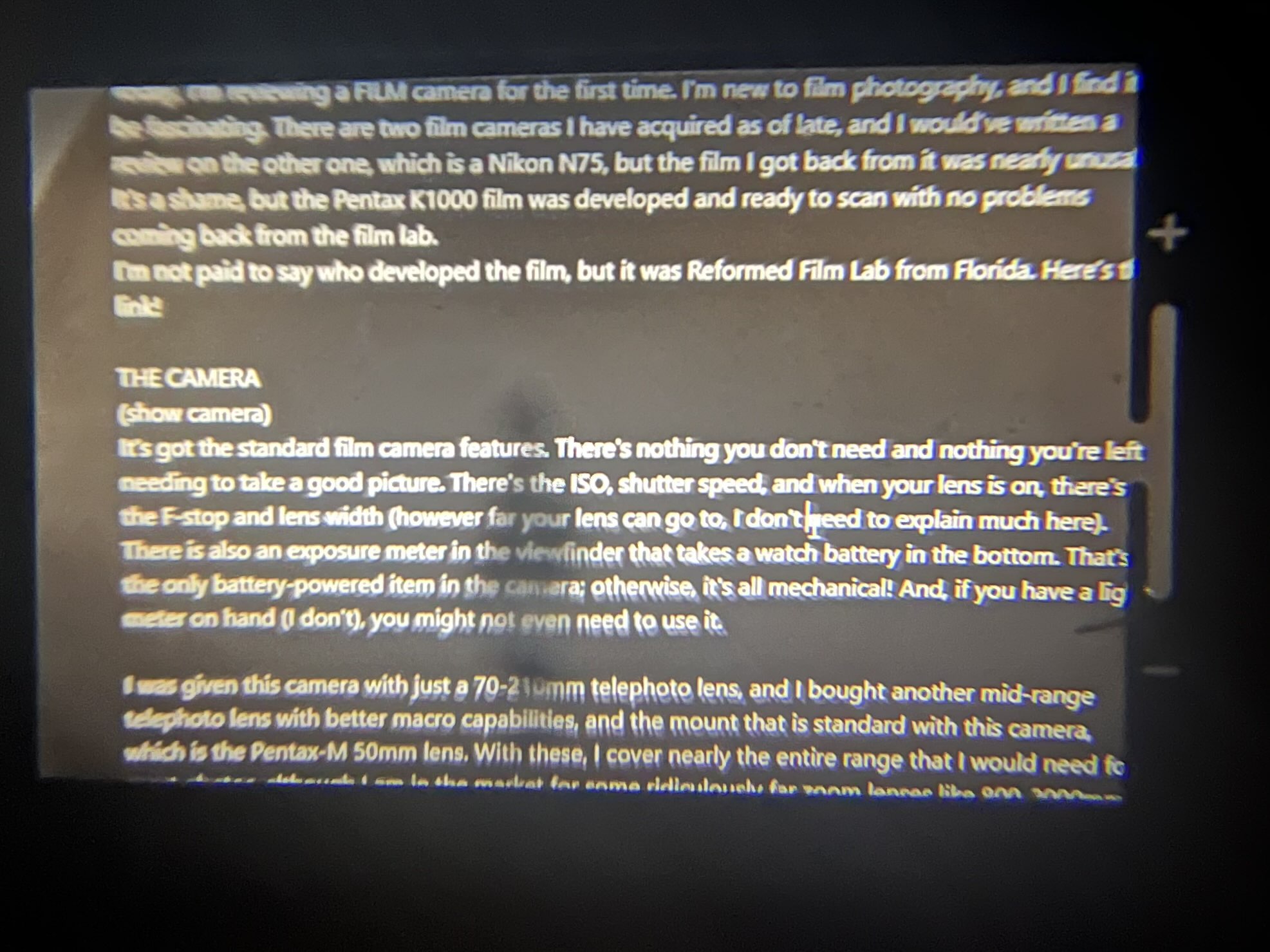August 20 2025
INTRO
Today, I'm reviewing a FILM camera for the first time. I'm new to film photography, and I find it to be fascinating. There are two film cameras I have acquired as of late, and I would've written a review on the other one, which is a Nikon N75, but the film I got back from it was nearly unusable! It's a shame, but the Pentax K1000 film was developed and ready to scan with no problems coming back from the film lab.
I'm not paid to say who developed the film, but it was Reformed Film Lab from Florida. Here's the link!
https://reformedfilmlab.com/THE CAMERA
It's got the standard film camera features. There's nothing you don't need and nothing you're left needing to take a good picture. There's the ISO, shutter speed, and when your lens is on, there's the F-stop and lens width (however far your lens can go to, I don't need to explain much here). There is also an exposure meter in the viewfinder that takes a watch battery in the bottom. That's the only battery-powered item in the camera; otherwise, it's all mechanical! And, if you have a light meter on hand (I don't), you might not even need to use it.

I was given this camera with just a 70-210mm telephoto lens, and I bought another mid-range telephoto lens with better macro capabilities, and the mount that is standard with this camera, which is the Pentax-M 50mm lens. With these, I cover nearly the entire range that I would need for most photos, although I am in the market for some ridiculously far zoom lenses like 800-2000mm. Zoom photography is my favorite because I intend to get knee-deep in nature photography one day, and I don't think I can get very close to most of the animals I want to photograph.
The only issue I have with this camera is that in the viewfinder, there is some visible kind of moss/organic rubble. It does not affect the photos, but it is a slight disturbance, and it frustrates me that I don't want to open the viewfinder to clean it. Doing so would risk causing some kind of problems internally, like moving pieces around that I shouldn't be. I cannot access the viewfinder from the mirror chamber of the camera because there is a window at the top of the chamber that feeds light into the viewfinder. I'm glad that I can still see the focus guide despite this problem.
Looking into this issue was educational. I now know that a large part of this camera is there only to feed light into the viewfinder. It could technically be removed along with the mirror if you didn't care about what your photos looked like. I guarantee you do.
PHOTOS
I don't know whether I'm reviewing the Fujifilm 400 film they sell at Walmart, the camera, or the Kodak film scanner with these negatives. Every film camera as standard as this does the same thing: there's no fancy color profiles or anything. This makes reviewing the photos depend on how well I shot, how nice the film is, and whether or not they made a camera that can shoot proper photos in the first place. One thing's for sure, the colors are really good!
I believe I did a decent job. I have a lot to learn, but I'm slowly getting there. Shooting in digital and film is teaching me a lot about how to balance the different shooting settings for a proper exposure. A major bottleneck is the scanner. at 22MP, it records the photos well enough, but in my opinion, it doesn't feel good to use. I presume it requires some degree of stability in order to scan the full image. BUT, the scan button is so stiff it makes me think I'll vibrate the scanner just enough to have a minor effect on the quality of the image scan.
There was also a light leak in the top left corner of the scans, but that could be attributed to my poor handling of the film tray. I will try scanning again when I have access to the scanner just to be sure.
Also there are dead pixels? I don't have a lot of faith in this scanner, so that's what I assume it is. But it's not a single dot here and there, and they're not confined to a bitmap grid. So, I guess I didn't clean the negatives properly before scanning them, or there's something very wrong with my film. It's only mildly infuriating.
The majority of the scans I took have been adjusted to give a proper range of lighting. Very few of them went over the threshold for overexposure, but some were certainly not exposed long enough.
CONCLUSION
Out of five stars? It's a five! The camera feels great to use, and with some really good lenses, I bet I could take my photography to the extreme with just this camera. I believe that with a film camera such as this one, as long as it's kept in good condition and you have the gear, there's no reason to ever switch systems. I see myself using this camera for a long time. Film is a little expensive to shoot and develop, though, so I have to plan film shoots.